



Helen Varley Jamieson’s account of working collaboratively in Madrid at the Eclectic Tech Carnival. On a ‘sprint’, with five women coming together for a week to rebuild the group’s website, physically & remotely.
In the last week of June I went to Madrid for the Eclectic Tech Carnival (/ETC) website workweek – the collective effort of five women coming together for a week to rebuild the group’s website. This is sprint methodology, a concept that I first met in Agile software development, but one that is being increasingly applied as a successful creative collaboration methodology. During the workweek I blogged about the process and this article is an assemblage of the blog posts.
Thinking about the concept of the sprint, I realised that over the years, I’ve participated in a number of theatrical “sprints” although we didn’t call them that. In fact it could be argued that the normal development process for theatre productions in New Zealand is the sprint – a three or four week turnaround of devising/rehearsing/presenting. Except that it doesn’t usually continue the Agile process after the first sprint – evaluation, refinement then the next sprint and iteration – and as a result, the work is often undercooked. But theatre projects that better fit the sprint analogy are some of the workshop-performance processes that I’ve participated in at theatre festivals, where a small group comes together for a few days to create a performance, then some time later meets again in another situation, perhaps a slightly different configuration of people, for another sprint. Each sprint generates a stand-alone performance or work-in-process showing, as well as contributes to a larger evolving body of work that forms the whole collaborative project. Two such projects that I’ve been part of are Water[war]s and Women With Big Eyes (with the Magdalena Project).

Recently I participated remotely in a Floss Manuals sprint, developing a manual for CiviCRM (which is something that I use with the Magdalena Aoteroa site). In this sprint, a group of about 15 people met somewhere in the USA to create a manual for CiviCRM. A few more of us were online, doing things like copy-editing the content. Most of the time there were people active in the IRC channel, chatting about the project and other things going on around them, so I got a sense of their environment, time zone and the camaraderie generated by the intense process.
Sprinting seems like a very logical and effective way to work in many situations: in software development, where each sprint focuses on specific feature development, and allows for a lot of flexibility and adaptation as the project progresses; in theatre, where limited resources make it a practical way to work, and the time pressure forces us to be resourceful and imaginative and also with networks, such as the Eclectic Tech Carnival, whose organisers don’t get to meet physically very often. It also makes sense in the context of our hectic lives, to block out a week or a few days when we agree to put everything else on hold and commit to intense, focused work instead of trying to juggle and multitask, with deadlines pushing out and out.
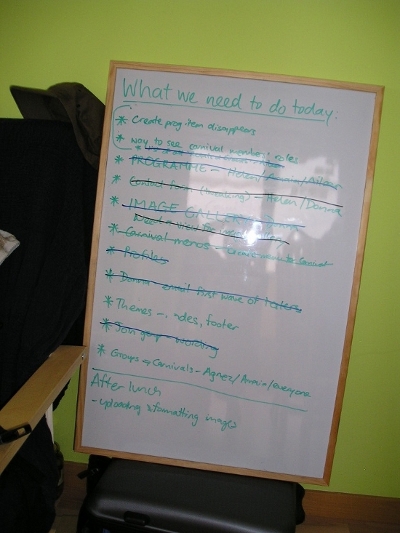
By halfway through the second day of the workweek, the wiki we used to plan and manage the project was filling up with tech specs, user requirements, design ideas, etc. We were getting encouraging emails from others in the network, and chatting to each other across the table and in the IRC. After lunch we did the new Drupal install and things seemed to be moving forward quickly in an organised and collaborative way.
Wednesday afternoon and the heat was oppressive; I put a little rack under my laptop because she was so hot, and my hands were too sweaty to use the trackpad. It wasn’t just Madrid’s weather that was making me sweat – we’d all been working hard on the new site since our late start in the morning (following on from a late night …). Agnes was busy developing the theme for the site, Aileen was working on profiles and user roles while Donna and Amaia were trying to configure mailing list integration and I was using the command line to drush download modules – much easier and quicker than the process of downloading, unpacking, ftp-ing and installing! And very exciting for me to use the command line, which I generally only get to do when hanging out with the /ETC crowd.

We were in that murky middle phase of the process: we’d done a lot of groundwork in terms of defining users, content types, general structure and the functionality required, but everything was still very bitsy and amorphous. But the installation of the test site had happened very easily yesterday, using drush, so that meant we now had something tangible to work with.
Working with Drupal can be pretty frustrating; it seems that every step of the way, another module is required to do what we want – then that module requires other modules, and then every little thing has to be finely configured to work just right with every other piece of the puzzle. From my previous experience with the Magdalena Aotearoa site, I knew we are doing a lot better this time in terms of defining what we need first, but some things we just can’t define until we know what’s possible, which we don’t really know for sure until we actually try it. We *think* we’re going to be able to do everything we want, but getting there isn’t simple. Also, the naming of different components and modules is sometimes ambiguous or confusing – the documentation ranges from really clear and detailed to non-existent. And some things just didn’t seem intuitive to me.
But, with five brains and our different complementary experiences and skills, I was still confident that we would have a new site by the end of Friday; maybe not a completely finished one, but a web site is never finished, is it?
On Friday morning the heat broke with a thunder storm and cooling welcome rain, but it didn’t last long. For some reason I woke up at 7.30am, ridiculously early as we hadn’t gone to bed until 2am. But I was wide awake so I enjoyed a couple of hours of quiet before everyone else awoke, drinking coffee and answering emails. The day before, Agnez and I had got up early to do yoga on the terrace, but the intense rain prevented that on Friday.
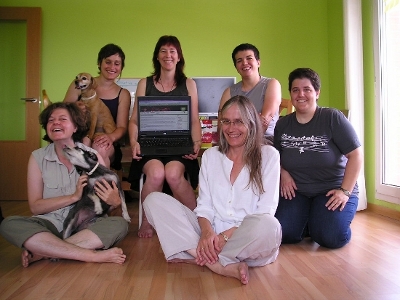
The test site was up and some of the others not present in Madrid were looking at it and trying things out. We’d solved a lot of problems but there were still a number of things not working. I had learned heaps about Drupal in the previous four days, particularly about organic groups, roles, permissions, and views. Altogether it is potentially incredibly flexible and powerful, however it takes time to work out how things need to be done and sometimes it is a confusing and circular process. Changing a setting in one place can stop something in a completely different place from working. However the combination of skills and experience between the five of us meant that usually one of us had at least an idea about how to do things and a couple of times we drew on external expertise via IRC or email.
On the last day, Agnez worked on finishing the theme while Aileen and I tried to work out why our groups are no longer displaying in the og_my view, and how to make the roles of group members visible. Donna had found that mailhandler and listhandler didn’t seem to be a practical way to integrate our mailman lists with Drupal after all – for the time being we’ll stick to the old system – and Amaia had been working on a way to create a programme for each event. The idea is that each /ETC event can be created as an organic group with the organisers having control over content and members within that group, but not being able to edit the rest of the site content. By Friday, we had this working pretty much how we wanted it.
We had planned a barbecue to celebrate the end of the workweek, but the rain prevented that. Instead, we ate inside then took turns to suffer humiliation and defeat with Wii Fitness (Amaia had clearly been practising!). In fact it wasn’t really the end of the sprint – rain again on Saturday morning meant that we decided to keep working longer and only went into the city in the afternoon, for a wander around and then the Gay Pride parade. On Sunday as we began to scatter back to our different parts of the globe, the site was still not live, as we were waiting for more feedback from testers and the finishing of the design themes. However, the site is essentially functional and should be live very soon.
The sprint process enabled us to achieve a considerable amount in a short space of time, sharing our knowledge and developing our skills. We also had great conversations over meals, explored Madrid and Colmenar Viejo, learned how to make Spanish tortilla, attempted a bit of Spanish, went swimming and did yoga. I even fitted in a performance on the first night, with Agnez, and dinner with friends another night. It’s amazing what you can do when you put the rest of your life on hold for a week; the only downside is the catching up afterwards.
Featured image: make art is an international festival focusing on Free/Libre/Open Source Software (FLOSS), and open content in digital arts
make art, one of the world’s most important free and libre art events, happens far away from the European metropolis, in the small town of Poitiers. However, it does not represent an integral piece of the ville‘s agenda to favour cultural tourism and development, as we might suppose thinking of some Brazilian film festivals and even of Bilbao’s Guggenheim. If something is to blame, it should be the grassroots effort of the native GOTO10 collective.
The name might sound familiar because not long ago they were doing a series of workshops in the UK to introduce FLOSS tools using their own pure:dyne operational system – a GNU/Linux distribution for multimedia creation. Having received some funding from the Arts Council, pure:dyne recently grew in efficiency and popularity.
Personally, the first time I heard about GOTO10 was in 2006, at that year’s Piksel festival. Some of the group’s members were there for audiovisual performances. Yes, they are artists as well – in fact, on the same days of make art, the group was taking part in the Craftivism exhibition, in Bristol. And between producing events, engineering software and, well, making art, they also found time to publish a book.
As diverse as these projects might be, they can all be inferred from the GOTO10’s creative practice, in respect of their real time interaction with people (in workshops) and machines (in live coding, etc). Given the way make art, pure:dyne and the group’s performances are interconnected, we could see them as one and the same activity, extending itself to various platforms.
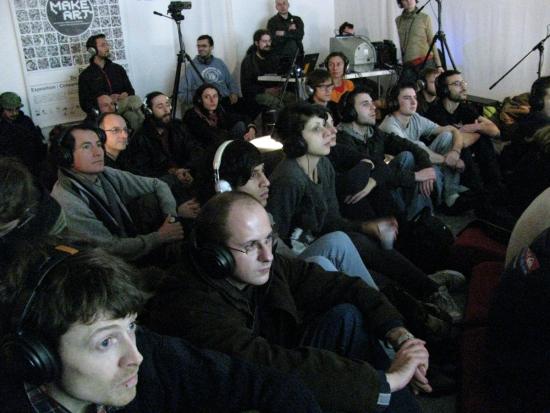
I wouldn’t go as far as to say that, similarly, GOTO10 is a poitou group that has been expanded to other parts of the world. But, now that it has members from Greece, the Netherlands, Taiwan and the UK, the localization of make art seems even more meaningful to the collective’s identity, hinting on where and why it started.
According to Thomas Vriet, one original member who is still in town and mainly responsible for make art production. The group first got together in 2003 to promote digital art performances, workshops and exhibitions in Poitiers – sharing thoughts and ideas on things they were interested in, but could not find in the local art scene or École de Beaux-Arts.
So, in the same way pure:dyne was developed to cope up with GOTO10’s own needs for a live operational system capable of realtime audiovisual processing, make art is the ideal festival they’d wish to attend in town. Both projects find their reason in the group’s artistic demands, and grew simultaneously from it: the inaugural version of the distro was released in 2005, right on time to be used in a workshop in the first make art the following year.
Even though make art’s production is concentrated locally, the event is curated online, by the whole of GOTO10. The other member directly implied in this year’s planning, Marloes de Valk, arrived from Amsterdam just in the first day of the festival. make art is a group initiative that cannot be isolated from the larger open source community – a circuit that includes not only artists and programmers, but other venues as well. It is from this sizeable repository that the pieces that constitute the event’s programme come from. The aforementioned Piksel, for instance, has previously contributed to make art with a special selection of Norwegian works, creating an unexpected interchange between Bergen and Poitiers.
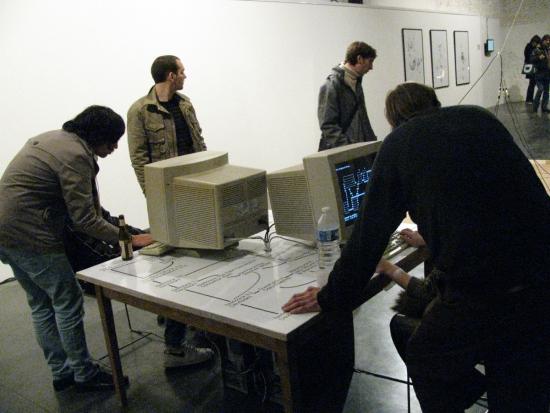
Together with the different Pixelache editions, these festivals form an international calendar of FLOSS art events, closely committed to developments in technology and aesthetics that, in many senses, are far more interesting that the new media proofs-of-concept proliferating elsewhere. But how does such package of extraordinary themes work in the traditional platform of the French countryside?
Altogether, make art seems to be the right size for Poitiers – not too small to feel incomplete, neither too big to feel overwhelming. The night programme may put you off if you are on a budget and decided to stay in the youth hostel (like me): there are no buses to that area after 8pm, forcing you to endure a half hour walk through cold streets. Apart from that, the city space is very well occupied by the festival, with the exhibition and debates in the central Maison de l’Architecture and a couple performances in other venues, emphasizing the curatorial logic. Posters are everywhere in town, competing for attention with those from the film festival.
However, the participation of the poitou community seems very restricted. So far, no local project has ever been sent in response to make art’s call. It might be that the theme is still alien to most people. Not surprisingly, the activity that attracted the majority of local public was the debate “Internet, Freedom and Creation” – which, beyond dealing with themes of more general concern (digital freedoms and copyright), was in French.
One of the efforts to increase this involvement was to open free places in the Fork a House! workshop to local students. Student volunteers could also be found mediating the exhibition and assisting production.
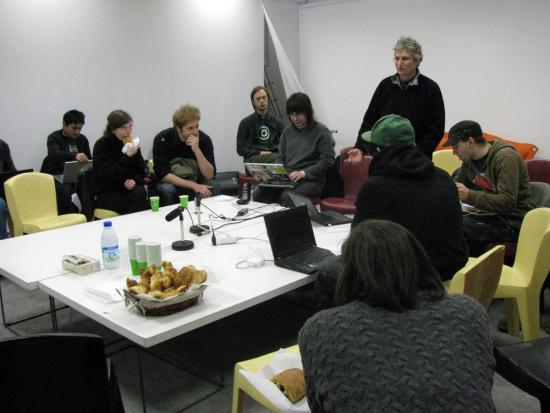
In that sense, the project that seemed to make the most of the festival’s situation was the frugal Breakfast Club. The first of these morning talks hosted by Nathalie Magnan was especially refreshing after the highly technical presentations the day before. Complex subjects were re-discussed over croissants, bringing the tone and rhythm of the event closer to the atmosphere of the #makeart IRC channel (which sometimes was livelier than the physical space).
The priority of Breakfast Club was not transparent accessibility but dialogue. Less of a tutorial and more like the public forum an open-source project cannot really do without. It made things more understandable to a laymen’s audience; it made the whole festival experience more coherent, pointing to directions in which it should grow within the city’s everyday life and structure – without having to be included in Poitiers’ tourism department masterplans.